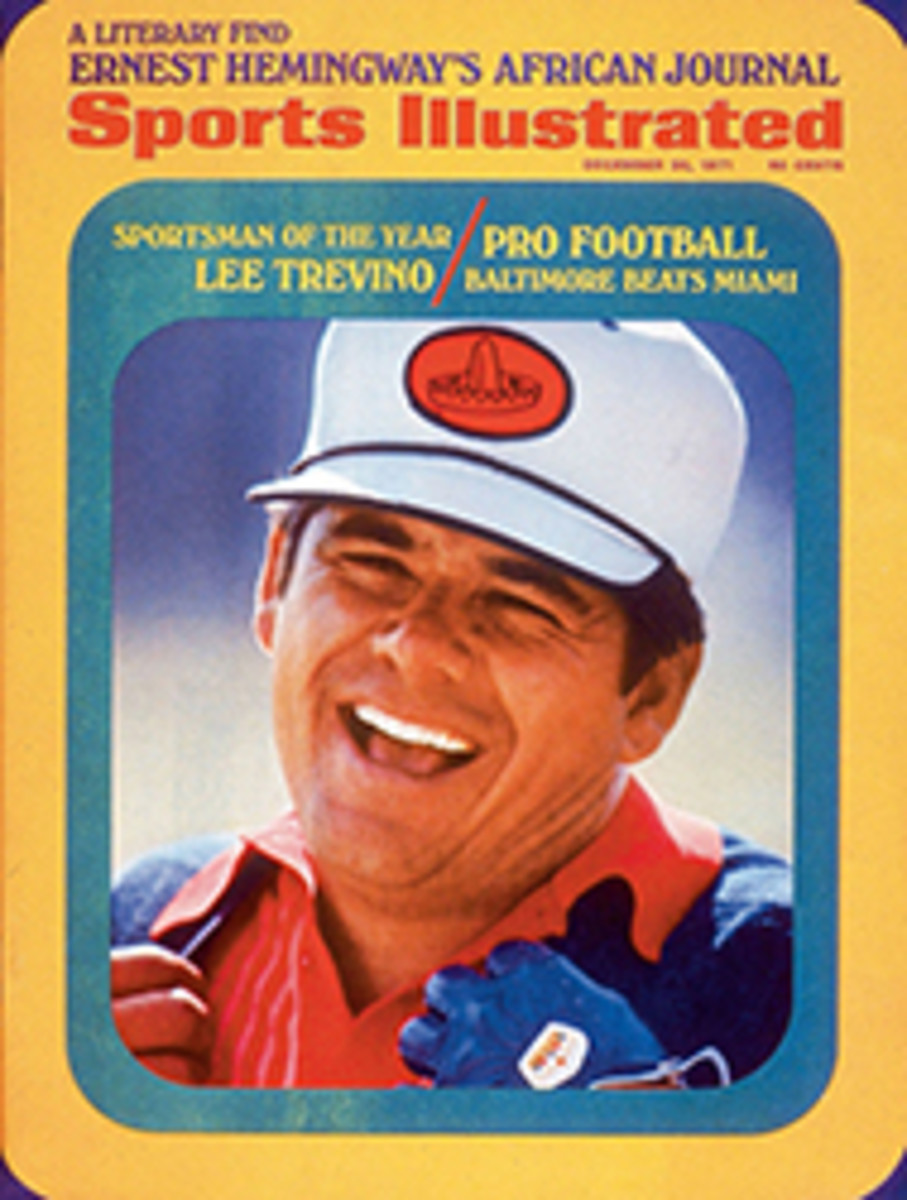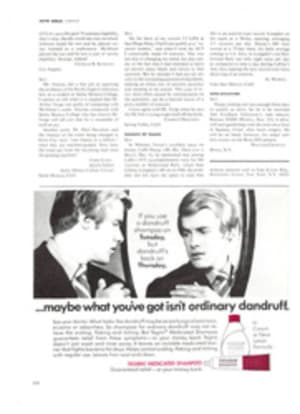
The Spider who finally came in from the cold
The two skiers come out of their twin aluminum starting gates like famished greyhounds and race into view high up on the slope, moving side by side through the two long rows of slalom poles. Halfway down, as they become momentarily airborne off the second of three small jumps that have been built into each course, it is suddenly evident that the racer on the left, whose row of flags is green, has swiveled his way into a slim lead over the skier on the right, whose flags are gold. He lands an instant before his rival. Over the last jump and through the final few poles he continues to increase his margin and finally passes under the bright yellow finish-line banner with a snap of his head to confirm his six-yard victory. Thus did Vladimir (Spider) Sabich win the slalom and giant slalom in the Samsonite Classic at Vail, Colo. And thus did American professional ski racing kick off its third, and perhaps most critical, winter of pole-to-pole, side-by-side match race competition.
The man-against-man pro circuit is the special baby of Bob Beattie, once the coach of the U.S. National Ski Team and now one of the sport's most energetic promoters. Beattie's version of the pro tour got off to a fragile start two seasons ago when all he could pull together were three race weekends for $8,500 in prize money and an outfit called The International Ski Racers Association—composed almost entirely of Billy Kidd, the first American male ever to win a gold medal in the FIS World Championship, and some retread Austrians. Now the numbers have a healthier glow. Last year there were nine race meetings offering total prize money of $127,000. Kidd, after an autumn of exhausting activity on the ski promotional circuit, didn't win a race. But while the tour lost Kidd, in spirit at least, it gained Sabich, the charismatic young Californian whose slashing, joyous racing style is a reflection of his social life. Sabich brought a touch of glamour to the tour, dominated it as well and emerged from last winter as leading money winner with a total of $21,189. Not exactly Nicklaus, but not bad for openers.
"It was such a relief to stop racing as an amateur," says Sabich. "I was fed up with the hypocrisy. Fed up with racing against guys who were making $50,000 a year, guys who had other people to wax their skis, sharpen their edges and who could go home when they got tired. I was too nervous trying to compete with what I thought were insufficient weapons. Now I have no worries."
"One of the reasons I think Spider is now skiing better than ever is that a free spirit like him could never thrive under the regimentation you have on a national team," says Kidd, an old friend from years together on the U.S. team and at the University of Colorado. "Now he does what he wants. He's loose, he's happy, he has freedom. And it shows in his skiing."
This year Sabich is back, obviously looser, happier and freer than ever. Kidd also is back, his own enthusiasm burning brightly once again, and Beattie has hopes of adding some more stars to his roster once the Winter Olympics in Sapporo have ended. ISRA membership is up to 100, and this year's tour schedule calls for at least 12 race meetings and prize money of almost $300,000.
Beattie has developed a new racing format keyed to slaloms and what he calls a dual challenge round of 16. This is head-to-head knockout competition conducted like a tennis tournament, and the field for this phase of each event is filled by the fastest 16 skiers from qualifying time trials held earlier. Each match is decided over two heats on parallel and almost identical courses, 12 to 15 feet apart, the contestants switching courses for the second heat. The racer who wins both heats, or compiles the largest overall winning margin by time, advances to the next round. The courses are usually set on intermediate slopes, seldom more than 600 or 700 yards long, and the racers are visible to the spectators at the bottom for almost the entire run. The whole event, from the first round of 16 to the final match, can be run off within 90 minutes. It all makes for quick, compact spectating.
"People can relate to two guys whipping down a mountainside trying to beat each other," says Beattie. "After a couple of rounds they also begin to identify with special favorites."
"This is certainly the most exciting form of ski racing there is," says Sabich. "For us as well as the spectators. You can see exactly what you have to do—which usually means go all out. If you finish second you're through. So for the guy behind, things can get really wild. You start cutting corners and taking chances because there's always a way to go faster. Against a clock you wouldn't take that gamble."
Races of this sort also present multiple problems to the skiers. They must learn how to get out of the starting gate extra fast, avoid collisions en route and cope with the jumps that Beattie inserts in each course. And an additional hazard was described at Vail by Jake Hoeschler, a former University of Colorado running back and downhill skiing star who lost to Kidd in the first round of the giant slalom.
"It's hard to concentrate on your own course with another skier right next to you," said Hoeschler, whose shaggy blond hair and bushy blond mustache make him look like a lion in goggles. "You listen for the other guy, as I did for Kidd. I lost my concentration, and suddenly I was flat on my face."
Despite the built-in gambles and thrills, the pro ski tour still faces parlous times; no one has yet figured out how to draw meaningful income from paying spectators. Television coverage, with its fat fees, has been slow in coming. Beattie must therefore rely almost entirely on commercial sponsorships, and hustling them up is about as tough as trying to footpack Mount Everest. "It's been a frantic scramble," he says. "Have you ever tried working with mirrors? That's us."
The skiing industry is currently in something of an overcrowded, unprofitable state, and, except for backing a few individual skiers on the tour or even a few teams, it can't be counted on to provide much important help. "The industry in the U.S. is still pretty soft," says Beattie. "It isn't stable enough yet to be a major financer. We have to go outside the business."
Outside the business means Benson & Hedges 100's, the tobacco firm which is putting up close to $100,000 this year in prize money; Samsonite luggage and Colorado Magazine, who supplied the $20,000 purse offered at Vail; and Du Pont, which will support future races.
In selling the tour, the sales pitch is not pegged strictly to exciting races and the crack skiers but also to its colorful personalities. There is Sabich, who flies, races motorcycles and figures that a night in which he hasn't danced on at least one tabletop is a night wasted. Jim Lillstrom, Beattie's P.R. man, also enjoys checking off some of the other characters. Norway's Terje Overland is known as the Aquavit Kid for the boisterous postvictory celebrations he has thrown. He's also been known to pitch over a fully laden restaurant table when the spirits have so moved him. Then there is the poet, Duncan Cullman, of Twin Mountain, N.H., author of The Selected Heavies of Duncan Duck, published at his own expense, who used to travel the tour with a gargantuan, bearded manservant. And Sepp Staffler, a popular Austrian, who plays guitar and sitar and performs nightly at different lounges in Great Gorge, N.J. when he isn't competing. The ski tour also has its very own George Blanda. That would be blond, wispy Anderl Molterer, the 40-year-old Austrian, long a world class racer and still competitive.
Pro skiing's immediate success, however, seems to depend on an authentic rivalry building up between Sabich and Kidd, who are close friends but whose living styles are as diverse as snow and sand. Sabich is freewheeling on his skis as well as on tabletops. Kidd is thoughtful, earnest, a perfectionist. Spider has his flying, his motorcycles and drives a Porsche 911-E. Billy paints and now drives a Volvo station wagon. Spider enjoys the man-to-man challenge of the pro circuit. Billy harbors some inner doubts regarding his ability to adapt to it.
"I'm not one of those competitive people who must win at everything at all cost—Ping-Pong, golf or whatever," Kidd says. "It's only true in skiing. Even then I've always felt that the most important struggle is primarily to get the most out of myself, not just beat the other guy. This man-to-man racing doesn't come naturally."
In Vail, Kidd—suffering slightly from flu and not yet competitively sharp—could progress no further than the quarterfinals in either event. Again the weekend belonged to Sabich. Spider won the giant slalom, surviving a scare in the semifinals when Overland, with a substantial lead, sailed too far off the final jump, missed a gate and was disqualified. In the slalom, Sabich survived another scare by Overland in the first round, but his protest against being called for missing a gate was upheld and he was able to sweep on through without the loss of another heat. This pair of victories plus point total was worth $6,500.
"Yes, Spider's the best right now," agreed Kidd after the race, sipping a glass of rosé, "but my ski technique is as good as it's ever been, too. By January I feel I'll be competitive. That's when you'll see what this tour can really produce."
PHOTO
SPIDER'S TAKE: ONE RACE, $2,500. TWO RACES, $5,000. THE WEEKEND: $6,500

